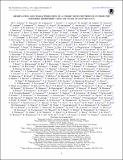OBSERVATION AND CHARACTERIZATION OF A COSMIC MUON NEUTRINO FLUX FROM THE NORTHERN HEMISPHERE USING SIX YEARS OF ICECUBE DATA
Author(s)
Arguelles Delgado, Carlos A; Axani, Spencer Nicholas; Conrad, Janet Marie; Jones, Benjamin James Poyner; Moulai, Marjon H.; Collin, G. H.; ... Show more Show less
DownloadAartsen-2016-OBSERVATION and CHARACTERIZATION.pdf (2.928Mb)
PUBLISHER_POLICY
Publisher Policy
Article is made available in accordance with the publisher's policy and may be subject to US copyright law. Please refer to the publisher's site for terms of use.
Terms of use
Metadata
Show full item recordAbstract
The IceCube Collaboration has previously discovered a high-energy astrophysical neutrino flux using neutrino events with interaction vertices contained within the instrumented volume of the IceCube detector. We present a complementary measurement using charged current muon neutrino events where the interaction vertex can be outside this volume. As a consequence of the large muon range the effective area is significantly larger but the field of view is restricted to the Northern Hemisphere. IceCube data from 2009 through 2015 have been analyzed using a likelihood approach based on the reconstructed muon energy and zenith angle. At the highest neutrino energies between 194 TeV and 7.8 PeV a significant astrophysical contribution is observed, excluding a purely atmospheric origin of these events at 5.6σ significance. The data are well described by an isotropic, unbroken power-law flux with a normalization at 100 TeV neutrino energy of (0.90 [subscript -0.27] [superscript +0.30]) x 10 [superscript -18] GeV [superscript -1] cm[superscript -2]s[superscript -1]sr[superscript -1] and a hard spectral index of ɣ = 2.13 ± 0.13. The observed spectrum is harder in comparison to previous IceCube analyses with lower energy thresholds which may indicate a break in the astrophysical neutrino spectrum of unknown origin. The highest-energy event observed has a reconstructed muon energy of 4.5 ± 1.2 PeV which implies a probability of less than 0.005% for this event to be of atmospheric origin. Analyzing the arrival directions of all events with reconstructed muon energies above 200 TeV no correlation with known γ-ray sources was found. Using the high statistics of atmospheric neutrinos we report the current best constraints on a prompt atmospheric muon neutrino flux originating from charmed meson decays which is below 1.06 in units of the flux normalization of the model in Enberg et al.
Date issued
2016-12Department
Massachusetts Institute of Technology. Department of PhysicsJournal
Astrophysical Journal
Publisher
IOP Publishing
Citation
Aartsen, M. G., K. Abraham, M. Ackermann, J. Adams, J. A. Aguilar, M. Ahlers, M. Ahrens, et al. “OBSERVATION AND CHARACTERIZATION OF A COSMIC MUON NEUTRINO FLUX FROM THE NORTHERN HEMISPHERE USING SIX YEARS OF ICECUBE DATA.” The Astrophysical Journal 833, no. 1 (December 1, 2016): 3. © 2016 The American Astronomical Society
Version: Final published version
ISSN
1538-4357
0004-6256